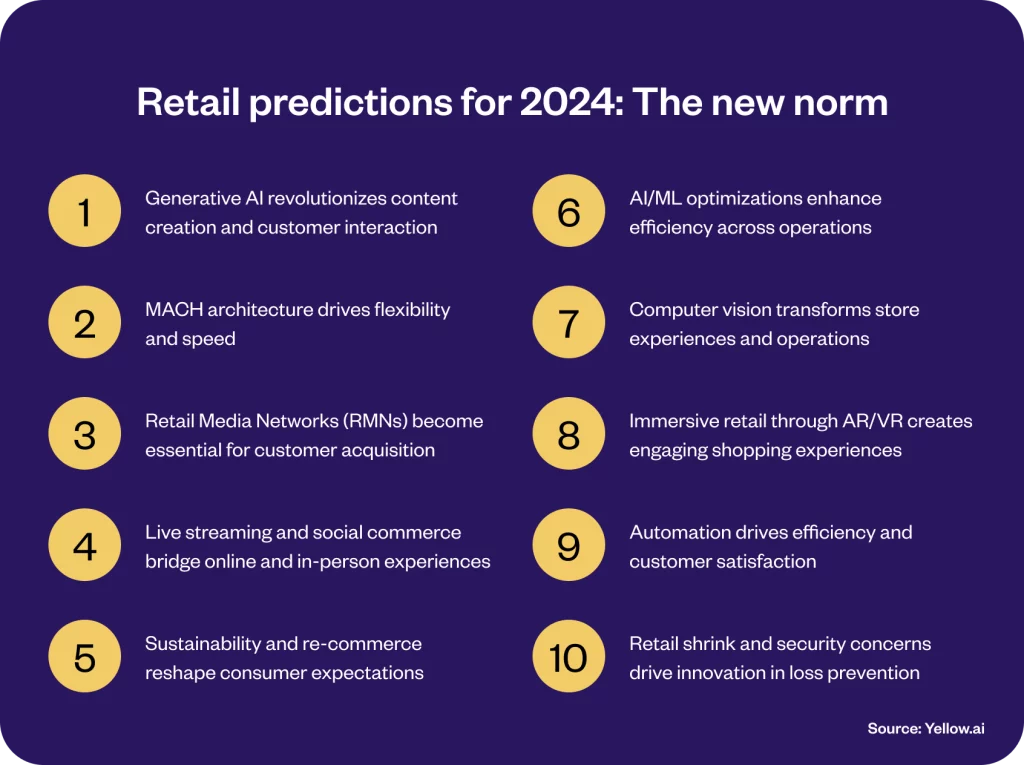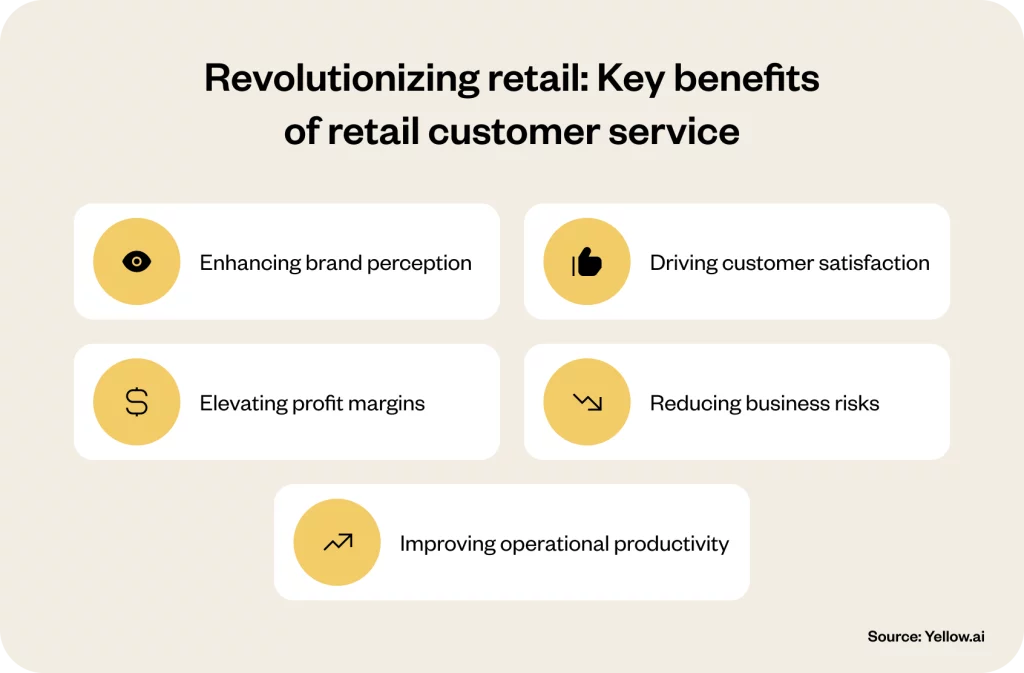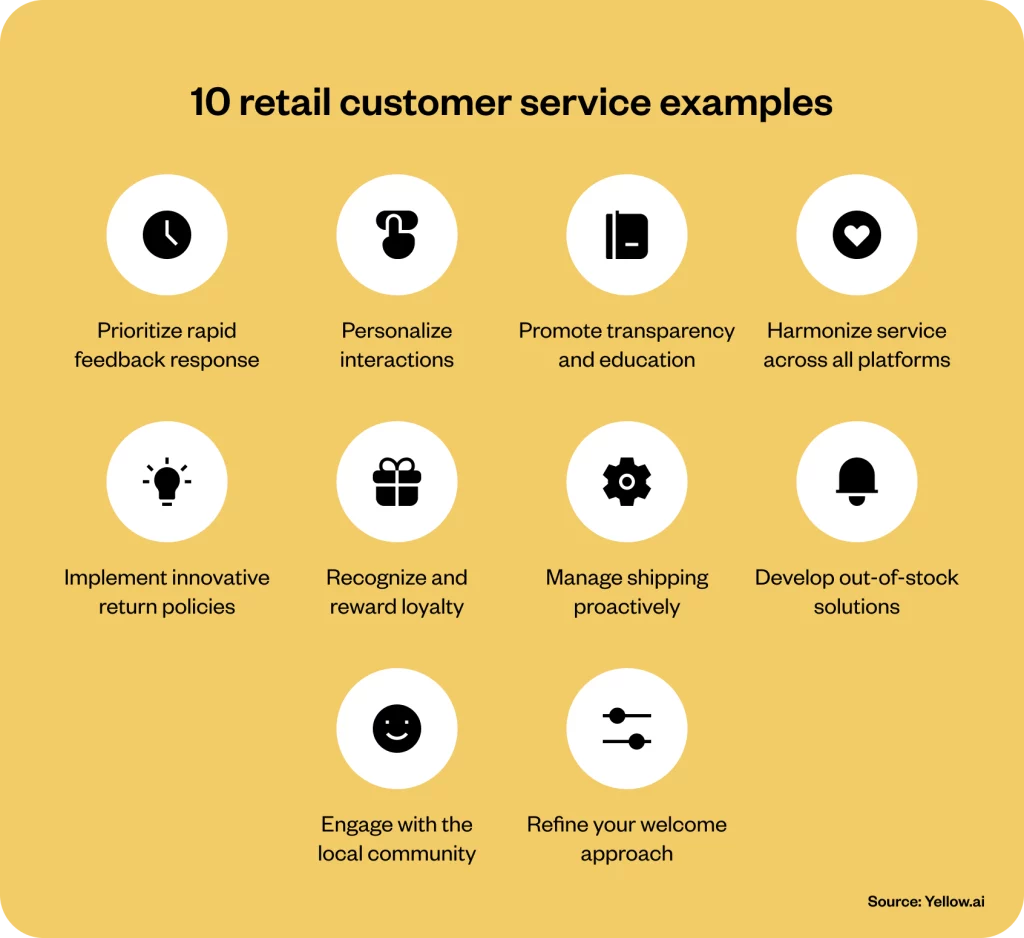Executive summary
The fast-paced retail landscape of today demands more than just transactions. It is a highly competitive space that calls for building genuine connections. This blog explores retail customer service, journeying from its core principles to the innovative tools reshaping how we interact with customers. It explains how stellar service can transform your retail business. We highlight some real-world examples and strategies you can implement right now. Whether you are getting to grips with the basics or integrating the latest in AI, this guide offers a holistic look at mastering customer service in the retail world.
Picture walking into a store where your presence is acknowledged with a warmth that feels like coming home. Imagine it as a place where every service interaction is carefully crafted to surpass your expectations. This vision is rapidly becoming the norm in retail customer service. In today’s retail battleground, winning customer loyalty is the ultimate prize. To do so, delivering exceptional service has to be the cornerstone of business survival. The evolution of retail customer service goes beyond merely embracing new tech; it’s about deeply understanding and addressing the core desires of every customer. Businesses that create experiences that linger long after purchase are the ones leading the retail game today.
The transformation in customer service in retail is a fundamental shift towards recognizing each customer interaction as an opportunity to build enduring bonds. From the initial greeting to the final word of thanks, the caliber of these moments can significantly distinguish a business in a saturated market. As we navigate through the changes in retail customer service (from age-old practices to adopting cutting-edge digital solutions), we will reveal the strategies modern retail giants employ to redefine service excellence. This blog explains how to nurture a community of loyal customers who feel genuinely seen and valued at every step of their journey.
Related must-reads:
- Customer service software: How to select the best one?
- Top 10 customer service tips for 2024: Elevate your support
What is retail customer service?
When you think of retail business success today, it is clear that the heartbeat of a successful retail business is not merely selling products but also crafting experiences that linger. That is where the power of retail customer service shines. Good customer service can turn the mundane act of shopping into a journey that feels both personal and rewarding. It is about greeting each customer with a warmth that makes them feel at home, ensuring their questions never go unanswered and their concerns are met with genuine care. In reality, retail customer service is the secret sauce to building a community of loyal customers who return, time and again, because they feel valued.
Retail customer service spans every interaction a customer may have with a brand. These interactions can be face-to-face, through a screen, or over a call. As a retail business, customer service is about weaving a seamless blend of personal touch with technological ease to make every touchpoint a delight. Whether it is the detailed product knowledge shared by a friendly staff member, the swift response to a tweet, or the easy navigation of an online store, each element plays a crucial role in enhancing the shopping experience. The aim is clear: to make every customer feel like they are the most valued asset. Businesses can do so by offering thoughtful, efficient support at every step of their journey.
For retailers eyeing the horizon for growth, investing in exceptional customer service is essential. It translates to training teams on the specs of the products and on how to listen, empathize, and connect with customers. It also means embracing tools like AI chatbots and live chat to ensure no customer query goes unanswered, no matter the hour.
Excellent retail customer service is about foreseeing what a customer needs before they ask, making their journey effortless and their experience memorable. This proactive, customer-centric approach is what can turn a simple purchase into a story worth sharing.
Related read: Customer experience in retail: Strategies and the future of CX
Retail predictions for 2024: The new norm
As the retail landscape continues to evolve at an unprecedented pace, staying ahead of emerging trends is more crucial than ever. The year 2024 will bring transformative shifts driven by technological advancements and changing consumer expectations. Here’s a glimpse into what the future holds for the retail industry.

1. Generative AI revolutionizes content creation and customer interaction
Generative AI will redefine how retailers engage with customers. Be it creating dynamic product descriptions or personalizing shopping experiences, generative AI will transform it all. The technology’s ability to generate rich, customized content on the fly will empower retailers to connect with consumers in more meaningful ways. Retailers that harness generative AI will come out as leaders as they will offer unparalleled customer service and engagement.
Related read: How to personalize customer experiences at scale
2. MACH architecture drives flexibility and speed
The adoption of Microservices, API-first, Cloud-native SaaS, and Headless (MACH) technologies will become a cornerstone for retailers seeking agility in their operations. This architectural approach enables rapid deployment of new services and seamless integration of the best solutions. As a result, it will facilitate a composable commerce ecosystem that can quickly adapt to market changes and consumer needs.
3. Retail Media Networks (RMNs) become essential for customer acquisition
As digital advertising landscapes evolve, RMNs will emerge as a critical platform for retailers to monetize their digital spaces. RMNs will also offer brands targeted advertising opportunities at the point of purchase. This direct-to-consumer channel will provide additional revenue streams and also enhance the shopping experience with relevant product discoveries.
4. Live streaming and social commerce bridge online and in-person experiences
The combination of entertainment and shopping through live streaming and platforms like Meta will continue to gain momentum, especially among younger consumers. Retailers adopting these channels can offer immersive, interactive shopping experiences that bridge the gap between online convenience and in-store engagement.
5. Sustainability and re-commerce reshape consumer expectations
Sustainability will transition from a niche concern to a mainstream expectation because consumers are demanding transparency and ethical practices from retailers. Similarly, re-commerce platforms for buying and selling used goods will increase. It will be driven by environmental concerns and the allure of finding value in pre-owned items.
6. AI/ML optimizations enhance efficiency across operations
Artificial Intelligence and Machine Learning (AI/ML) will continue to be instrumental in optimizing retail operations. They will play a crucial role in operations ranging from demand forecasting to personalized customer experiences. As AI/ML technologies become more accessible, retailers will harness these tools for a wide range of applications to enhance operational efficiency and customer satisfaction.
7. Computer vision transforms store experiences and operations
Advancements in computer vision technology will offer retailers new ways to enhance customer experience and streamline store operations. From checkout-free shopping experiences to improved inventory management, computer vision will become a critical component in physical retail innovation.
8. Immersive retail through AR/VR creates engaging shopping experiences
Augmented Reality (AR) and Virtual Reality (VR) will take the shopping experience to new levels of engagement. They will do so by allowing customers to visualize products in their own space or immerse themselves in virtual stores. This technology will entertain and also inform purchasing decisions. That will make it easier for customers to choose products confidently.
9. Automation drives efficiency and customer satisfaction
In response to agent shortages and the need for precision, automation will play a pivotal role in both back-end operations and customer-facing services. From automated warehousing to AI-driven customer service, automation will help retailers deliver consistent, high-quality service.
Related read: Customer service automation – A full guide
10. Retail shrink and security concerns drive innovation in loss prevention
As retail shrinkage becomes an increasing concern, retailers will look for innovative solutions to minimize loss without compromising the customer experience. Technologies such as advanced surveillance, AI-driven anomaly detection, and more secure payment methods will become standard.
Revolutionizing retail: Key benefits of retail customer service
The landscape of retail is ever-evolving, and at its core is retail customer service. Exceptional customer service is the catalyst for transformation and growth. Let us outline five critical advantages of prioritizing customer service and how it can redefine the retail experience.

Related read: 10 Bad customer service examples (How to fix them)
1. Enhancing brand perception
A positive service experience is the most effective advertisement. Quick and efficient solutions (like speeding up checkout processes) leave a lasting impression and also encourage customers to share their experiences. This organic promotion elevates your brand’s reputation and attracts new customers while keeping the existing ones loyal.
Reducing wait times significantly through improved POS systems is a prime example of service excellence that customers are likely to mention in their circles. It will broaden your brand’s reach and appeal.
2. Driving customer satisfaction
The happiness of your customers directly influences the overall success of your retail business. It affects everything from investor confidence to bottom-line results. Achieving customer satisfaction means consistently delivering beyond expectations and securing a solid foundation for business growth and stability.
Actively responding to customer feedback, such as enhancing POS interfaces or implementing loyalty programs, showcases your commitment to customer satisfaction. It will help you build a trustful and loyal customer base.
3. Elevating profit margins
The link between customer satisfaction and profitability is undeniable. Superior customer service encourages repeat business and also turns satisfied customers into advocates for your brand. That ensures a steady flow of revenue and the opportunity for further business enhancements and growth.
Reinvesting in your business based on customer preferences and feedback strengthens your market position and supports sustained financial growth.
4. Reducing business risks
A deep understanding of your customer’s needs and preferences allows for a proactive approach to retail management. It significantly reduces the potential for business downturns. Tailoring your services to meet these needs ensures your retail operation remains relevant and competitive.
For instance, introducing a customer-requested loyalty program can increase retention rates and reduce the risk of customers switching to competitors.
5. Improving operational productivity
A culture that values exceptional customer service naturally motivates employees to take initiative and strive for excellence. Witnessing the positive impact of their efforts on customer satisfaction and business performance increases staff motivation and productivity.
Employee-driven initiatives, such as optimizing the use of a POS system to enhance customer experience, streamline operations, and also contribute to a positive work environment and customer satisfaction.
10 Tips to improve customer service in retail
Improving customer service in retail is crucial for enhancing customer satisfaction, loyalty, and overall business growth. Here are some practical ways retail businesses can implement to elevate their customer service.

1. Implement real-time engagement through live chat
Customers today expect immediate responses to their inquiries. Traditional methods can lead to frustrating delays and missed sales opportunities.
Implementing live chat enables instant communication. It offers real-time assistance to customers as they navigate your website. This immediate support system can significantly enhance the shopping experience and make it more likely for customers to complete their purchases.
Implementation tips
- Quick response times: Ensure your live chat is handled during peak hours with trained staff ready to answer queries.
- Use chatbots for off-hours: Integrate AI chatbots to handle basic inquiries during non-business hours, ensuring continuous engagement.
2. Leverage AI-driven chatbots for efficient customer interaction
Providing 24/7 customer support is challenging, especially for small to medium-sized businesses with limited resources. However, AI-driven chatbots can handle a wide range of customer service tasks and help you offer 24/7 customer support.
AI chatbots can handle a range of operations, from answering FAQs to guiding users through the purchase process, regardless of the time of day.
Related read: How to create a FAQ chatbot + examples, types, benefits
Implementation tips
- Personalization: Utilize AI chatbots to offer personalized shopping advice based on customer browsing history.
- Integration: Seamlessly integrate chatbots with your CRM to provide cohesive customer experiences.
Want to know how AI-driven chatbots can enhance customer experience in your retail business with seamless integration, personalization, and 24/7 support? Book a demo with Yellow.ai and experience the magic AI chatbots bring to your business.
3. Establish direct communication with phone support initiatives
Digital channels can’t always provide the reassurance or detailed support some customers need. However, offering direct phone support can help. It ensures customers can reach a human representative for complex issues or reassurance. A combination of direct communication channels and AI chatbots can enhance trust and satisfaction significantly.
Implementation tips
- Training: Equip your phone support team with in-depth product knowledge and soft skills to handle sensitive customer interactions effectively.
- Accessibility: Prominently display your support phone number on your website and social media platforms to ensure customers can easily find it.
4. Uphold integrity with authentic commitments
Overpromising and underdelivering can quickly erode customer trust and loyalty. Hence, you should set realistic expectations about your products and services. When you make a commitment, be it regarding delivery times or product capabilities, ensure you can meet or exceed these promises.
Implementation tips
- Transparency: Be honest about what your customers can expect from your service and products.
- Consistent communication: Keep customers updated about their orders, especially if there are delays or issues.
5. Adopt a customer-centric listening approach
Many businesses fail to understand and act on customer feedback fully. Hence, they miss out on opportunities to improve. As a business, actively listen to your customers across all channels, including social media, in-store feedback, and online reviews. Use this feedback to drive meaningful changes in your service or product offerings.
Implementation tips
- Feedback loops: Create mechanisms for customers to provide feedback quickly and demonstrate how this feedback leads to changes.
- Employee training: Train your staff in active listening skills and empower them to make customer-centric decisions.
6. Proactively address and resolve customer grievances
Unaddressed customer complaints can escalate into negative reviews and lost business. Hence, businesses must develop a proactive approach to identify and resolve customer issues before they escalate. It includes monitoring social media, reviewing customer feedback, and having a responsive customer service team.
Implementation tips
- Empower employees: Give your team the authority to resolve issues promptly.
- Follow-up: After resolving an issue, follow up with the customer to ensure they are satisfied with the solution.
7. Invest in advanced training for customer service excellence
Inconsistent customer service quality can tarnish your brand’s reputation. So, you should regularly invest in comprehensive training programs for your staff. The training programs should focus on product knowledge, communication skills, and problem-solving techniques.
Implementation tips
- Ongoing training: Make training an ongoing process, incorporating role-playing and customer service scenarios.
- Feedback-driven learning: Use customer feedback to tailor training programs, focusing on areas needing improvement.
8. Encourage going the extra mile
In a competitive retail environment, standard service may not be enough to distinguish your brand. So, build a culture that encourages employees to exceed customer expectations. You can do so through personalized service, unexpected perks, or thoughtful gestures.
Implementation tips
- Reward initiative: Recognize and reward employees who demonstrate exceptional service.
- Empowerment: Allow employees the freedom to make decisions that enhance customer satisfaction without needing managerial approval.
9. Elevate retail customer service to a competitive advantage
Differentiating your retail business in a crowded market is challenging. You should make outstanding customer service your key differentiator. It means meeting and exceeding customer expectations in every interaction.
Implementation tips
- Brand messaging: Include your commitment to exceptional customer service in your marketing and brand messaging.
- Continuous improvement: Regularly assess your service levels and look for new ways to improve.
10. Personalize interactions to enhance customer relationships
In an era of digital commerce, customers still crave personalized, human-centric service experiences. So, use customer data to personalize interactions, from greeting customers by name to tailoring recommendations based on their preferences and purchase history.
Implementation tips
- Leverage technology: Utilize CRM systems to store and analyze customer data, enabling personalized service.
- Training on personalization: Train your staff to use the information available to them to make each customer feel special and valued.
10 Retail customer service examples
Delivering exceptional customer service is a critical differentiator in the retail sector. Below, we explore ten practical examples of how to elevate their customer service game.

1. Prioritize rapid feedback response
Immediate responses to customer feedback (positive or negative) show that your business values customer input and is committed to continuous improvement. For instance, a clothing retailer swiftly addressing an online complaint about a product resolves the specific issue. It also demonstrates to all potential customers the retailer’s dedication to satisfaction.
2. Personalize interactions
Tailoring interactions to fit each customer’s preferences and history with your brand can significantly enhance their shopping experience. Consider a jewelry store that remembers a customer’s style preferences and upcoming anniversaries. It accordingly suggests relevant pieces. In doing so, the brand is likely to see higher engagement and repeat business.
3. Promote transparency and education
Customers today expect honesty and clarity from the brands they patronize. Imagine the example of a health food store that educates its customers about the nutritional benefits and sources of its products. By doing so, the brand fosters trust and loyalty. Offering workshops or creating informative content can further this engagement.
4. Harmonize service across all platforms
Consistency in customer service, whether in-store, online, or through social media, reassures customers of your reliability. For example, an electronics retailer ensures that its online chat support is as knowledgeable and helpful as its in-store staff provides a seamless customer experience. It will strengthen brand loyalty.
5. Implement innovative return policies
Flexible return policies remove barriers to purchase and demonstrate confidence in your product quality. Consider a bookshop that allows returns of books within a month of purchase if not satisfied. Doing so will ensure that the brand encourages more people to try new genres without risk.
6. Recognize and reward loyalty
Rewarding repeat customers with exclusive offers or loyalty points acknowledges their value to your business and also incentivizes continued patronage. For instance, a coffee shop offering a free cup after ten purchases motivates customers to keep coming back. It enhances customer lifetime value.
7. Manage shipping proactively
Proactive communication about shipping, especially when there are delays or issues, can mitigate customer frustration. For instance, an online retailer updates customers about their order status at every step, promptly addresses any delays, and maintains trust even in the face of logistical challenges.
8. Develop out-of-stock solutions
When items are out of stock, offering to notify customers when they’re available again or suggesting similar alternatives keeps the customer engaged and open to making a purchase. For example, a sportswear store could offer to email customers when a popular running shoe is back in stock or suggest a similar style in the meantime.
9. Engage with the local community
Connecting with your community through events or local causes creates a positive brand image. It can also drive local support. For instance, a pet store hosting adoption events with a local animal shelter supports a good cause and also draws in animal lovers who are potential customers.
10. Refine your welcome approach
A warm, personal greeting sets a positive tone for the entire shopping experience. Consider the example of a home decor boutique. The boutique takes the time to understand a customer’s project or style preferences upon entry. It can offer more tailored assistance, making the visit more productive and enjoyable for the customer.
How Yellow.ai can transform your retail customer service?
Staying ahead in retail means exceeding customer service expectations. That is where Yellow.ai steps in, bringing cutting-edge AI-driven solutions to the forefront of retail customer service. With Yellow.ai, businesses can harness the power of advanced chatbots, leveraging technologies like Natural Language Processing (NLP), No-code chatbot builders, Multilingual support, and Lifelong Learning Platforms (LLP) to offer unparalleled customer experiences.
- Natural Language Processing (NLP): Yellow.ai’s NLP technology enables chatbots to understand and interpret customer queries in a natural, human-like manner. It ensures that customer interactions are smooth, making communication as intuitive and straightforward as speaking with a human representative.
- No-code chatbot builders: With Yellow.ai’s no-code platform, retailers can easily design, build, and deploy AI chatbots without needing any technical expertise. This feature democratizes the use of advanced AI, allowing retailers of all sizes to implement cutting-edge customer service solutions quickly.
- Multilingual support: Yellow.ai’s platform supports multiple languages, enabling retailers to serve customers across the globe in their native language. This feature breaks down language barriers, making your retail business more accessible and inclusive.
- Lifelong Learning Platform (LLP): The LLP ensures that Yellow.ai’s solution learns from every interaction, continuously improving its responses and the quality of support provided. This feature means that the more you use Yellow.ai, the better it gets at serving your customers.
- Integration capabilities: Yellow.ai can be seamlessly integrated with existing CRM, ERP, and other business systems, ensuring access and utilization of customer data to provide personalized and informed support and enhance the overall customer experience.
- Advanced analytics: With Yellow.ai, retailers gain access to deep insights into customer behavior and preferences. These analytics help in making informed decisions, tailoring marketing strategies, and continuously improving service offerings based on real customer feedback.
To see how Yellow.ai can revolutionize your retail customer service, book a demo today. Experience firsthand the difference AI can make in transforming customer interactions and driving your business forward.
The final thoughts
As we look toward the horizon of retail’s future, it is clear that innovation and customer service excellence are inextricably linked. Embracing technologies like AI, ML, and NLP is setting a new standard for customer engagement and satisfaction. With solutions like Yellow.ai, retailers have the opportunity to lead the charge and offer experiences that build meaningful interactions.
The journey of redefining retail customer service is ongoing. But with the right tools and a commitment to excellence, the path ahead is promising. It is time for retailers to embrace the future, where technology and human-centric service collide to create shopping experiences that are memorable, efficient, and, above all, customer-focused.
Frequently asked questions (FAQs)
What defines excellent customer service in retail?
Excellent customer service in retail is characterized by timely, empathetic, and personalized interactions that exceed customer expectations. It involves understanding customer needs, providing accurate and helpful information, and ensuring a positive shopping experience from start to finish.
How many customer segments exist in retail?
Retail customer segmentation typically includes demographic, geographic, psychographic, and behavioral segments. These segments help retailers tailor their offerings and service strategies to meet the diverse needs and preferences of their customer base effectively.
What key skills are crucial for retail customer service?
Key skills for retail customer service include effective communication, empathy, problem-solving, product knowledge, and adaptability. These skills enable service representatives to understand and meet customer needs, resolve issues efficiently, and adapt to varying customer interactions.
What main metrics track retail customer service success?
The main metrics to track retail customer service success include customer satisfaction scores (CSAT), Net Promoter Score (NPS), first response time, resolution time, and customer retention rates. These metrics provide insights into the effectiveness of customer service efforts and areas for improvement.
How should we effectively address retail customer complaints and feedback?
Effectively addressing retail customer complaints and feedback involves actively listening to the customer, acknowledging their concerns, providing a timely and appropriate resolution, and following up to ensure satisfaction. It also includes learning from feedback to prevent future issues.
How does technology improve the customer service experience in retail?
Technology improves the customer service experience in retail by enabling more efficient, personalized, and accessible service. AI-driven chatbots, CRM systems, and analytics tools help retailers understand customer needs, provide immediate assistance, and personalize interactions to enhance overall satisfaction.

















